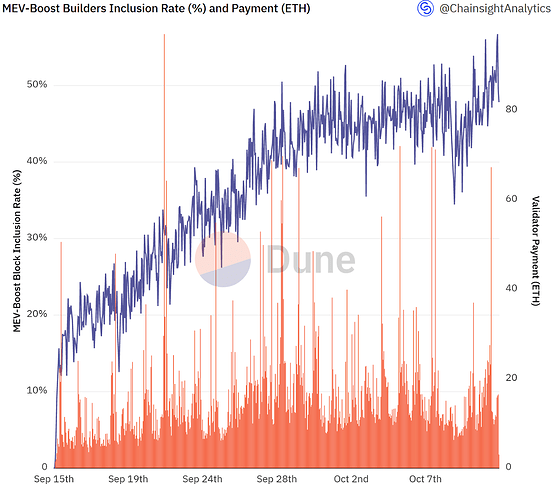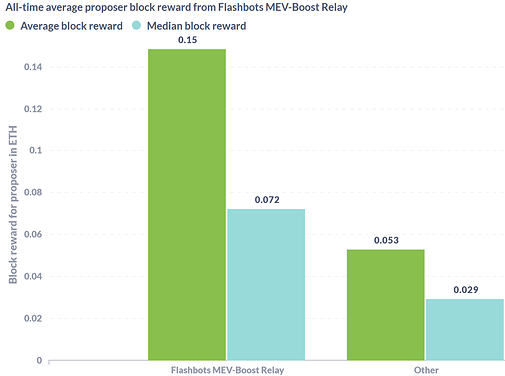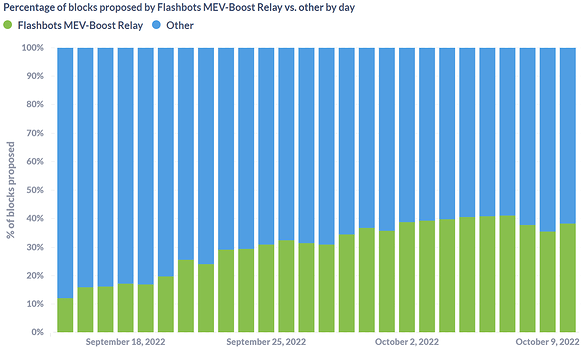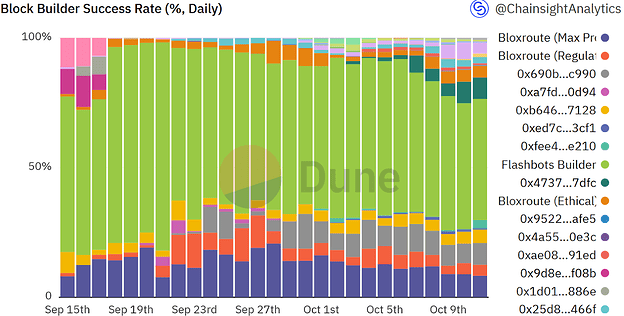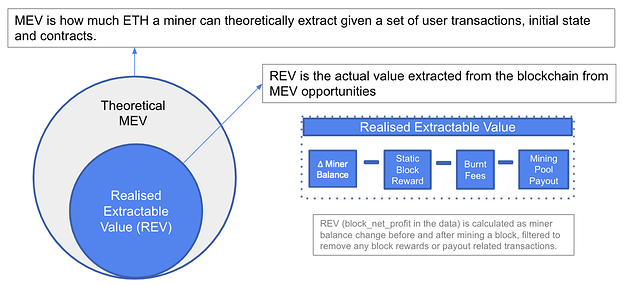The wait is over – Ethereum has transitioned to PoS, MEV-Boost is live and the Flashbots Transparency Reports are back! This edition will cover highlights from the weeks leading up to the merge until today, the start of Devcon VI in Bogota.
Overview
![]() Hi everyone! Fred here – new to the Flashbots collective but a long-term Ethereum enthusiast. I’m excited to join and help steward our community as we enter this new era for both Ethereum and Flashbots. I will work to reduce the information overload by publishing monthly reports that cover recent developments, research, discussions and events related to Flashbots.
Hi everyone! Fred here – new to the Flashbots collective but a long-term Ethereum enthusiast. I’m excited to join and help steward our community as we enter this new era for both Ethereum and Flashbots. I will work to reduce the information overload by publishing monthly reports that cover recent developments, research, discussions and events related to Flashbots.
I’m looking forward to having the Flashbots Transparency reports once again serve as both a snapshot on our journey and as a conversation starter for our community. The focus of this edition will be the Merge, the implications it has on MEV and the adoption of MEV-Boost.
With the merge behind us an important phase for Flashbots has come to an end. Mev-geth as a single client implementation has been replaced by MEV-Boost, a sidecar that can plug into any consensus client. The risk of validator centralization due to MEV extraction is being reduced by proposer builder separation and permissionless access to a competitive market for block building. At the time of writing, almost 50% of proposed blocks are being relayed through MEV-Boost and validators proposing blocks from MEV-Boost are on average earning almost 300% more in block rewards.
This report will start by recounting the final preparations leading up to the Merge and activation of MEV-Boost before taking a look at where we are today. We will also present our recently published research papers, and highlight community resources and ways to get involved.
The weeks leading up to the merge
MEV-Boost was thoroughly tested and optimized ahead of merge to work with all clients through collaboration with the Flashbots Eth2.0 Working Group. Achieving compatibility with every client is a major upgrade to the previous structure in proof-of-work Ethereum which required miners to run mev-geth in order to participate in the Flashbots auction.
To prepare searchers with regards to how MEV-Boost impacts their operations, Brock Smedley published Searching Post-Merge. The post explores the impact of proposer/builder separation and gives some considerations to keep in mind when choosing block builder. If you are a searcher reading this – make sure to also give the Searchers Self-Support part of the forum a visit!
Flashbots Protect – The Merge & Beyond by Angela Lu provides a year in review of Flashbots Protect and presents improvements that followed from the merge. Users of Flashbots Protect today will experience both faster time to inclusion and revert protection. MEV-Boost may also open the door for a couple of new UX features to Flashbots Protect such as account abstraction, sponsored transactions, fee payment in ERC20 tokens, user MEV kickbacks and more.
In response to the legal requirements for relay providers in their home jurisdictions, we decided to accelerate the release of our relay code as open source under a AGPL-license. This is core to our mission of minimizing MEV-related harms to public blockchains and their users. Additional context on how we are working to reduce the reliance on the Flashbots relay can be found at the end of the next section below.
The Merge and today
As the Ethereum community celebrated TTD and the first PoS block to include execution layer transactions, the pressure was not quite over for the Flashbots engineers and researchers. In order to reduce technical complexity and moving parts at the merge, MEV-Boost waited until 17 epochs had been finalized before activation. Just like the merge, activation of MEV-Boost went smoothly and the Flashbots MEV-Boost relay successfully started sending bids beginning at epoch 146,892.
A bug with the initial version of MEV-Boost was found shortly after activation which caused three missed slots when a deposit was included. The bug was resolved in MEV-Boost v1.3.1 the following day, a full post-mortem of the event and fix can be found here. Expect improvements to continue as we strive to optimize and make things even more efficient.
As of today, roughly a month after the Merge, MEV-Boost has reached 50% adoption from validators, earning them on average almost 300% more in block rewards.
From the MEV-Boost Dashboard by ChainsightAnalytics
From the Flashbots Transparency dashboard
The Merge and MEV-Boost brings significant technical and structural changes to how Ethereum’s MEV marketplace works. As part of our effort to illuminate this dark forest and provide transparency we have launched Flashbots Transparency dashboard and Flashbots MEV-Boost Relay to provide metrics related to the Flashbots MEV-Boost relay and builder. We will continue to improve the dashboard with additional metrics as more data becomes available. Our goal is to set a standard for open, transparent data policies that the wider community will adopt and continue to expand upon. For more details about the dashboard, please read the official announcement.
7 relayers have so far relayed blocks through MEV-Boost (Flashbots, BloXroute Max Profit, BloXroute Ethical, BloXroute Regulated, Blocknative, Manifold & Eden). To bootstrap relay competition we deliberately avoided enshrining the Flashbots relay as default in MEV-Boost. We do however see that the Flashbots relay is currently relaying 84% of MEV-Boost blocks, 42% of all blocks proposed on the network.
From the Flashbots Transparency dashboard
27 unique builders have so far had blocks proposed through MEV-Boost. The first days after the Merge the Flashbots builder was producing 80% of MEV-Boost blocks, the trend has been going down ever since and today that number is roughly 50%. Every block that is built by Flashbots contain a reminder of our commitments and our approach to mitigating the MEV crisis:
- To Illuminate the Dark Forest,
- To Democratize Extraction, and
- To Distribute Benefits
From MEV-Boost Dashboard by ChainsightAnalytics

From @0xdef1
Toward an open research and development process for MEV-Boost
MEV-Boost is built by Flashbots in collaboration with the Ethereum Foundation and client teams as neutral infrastructure. Flashbots are committed to building an open, permissionless, and transparent MEV ecosystem and MEV-Boost is designed from the ground up with Ethereum security as the primary objective.
To reduce reliance on Flashbots and accelerate the on-going maturation of the market we will submit our builders’ blocks to other relays to help them bootstrap adoption. We will also be open sourcing more of our knowledge and infra in the coming weeks.
We will commit additional resources to research ways to limit builder power and centralization, for example by using inclusion lists. We are also issuing a grant for the development of a relay monitor, which will help the community impartially evaluate and monitor the performance of relays.
For additional context on MEV-Boost, our (currently) centralized infrastructure, and competition please see this note posted by Robert Miller.
The systemic importance of MEV-Boost makes it necessary to be thoughtful about how ongoing research and development should be organized. Chris Hager initiated a conversation on the forum to kickstart the discussion on what a collaborative, open and effective R&D process to MEV-Boost should look like. Please join the conversation and share your thoughts on how we can collectively navigate the path forward!
Flashbots Research
Order flow, auctions and centralisation
Quintus Kilbourn published a two-part article on order flow, auctions and centralisation. The first part describes the potential for exclusive order flow (EOF) to centralize the builder market and render it uncompetitive. Having uncontestable builders with disproportionate control over the incentives of the network would be a serious threat to PBS and the health of Ethereum.
The second part looks at order flow auctions as a way to counteract the dangers of EOF and describes how “explicit” and “implicit” auctions can help a user internalize MEV. The article argues that order flow auctions can address part of the EOF problem and explores meaningful differences between these two auction design types, while identifying similarities that point to a more fundamental problem.
Feel free to also watch the presentation from SBC-MEV and participate in discussion on the forum (part I, part II).
Modelling Realised Extractable Value in Proof of Stake Ethereum - an update of validator return post-merge.
Elaine Hu published a paper that presents three methodologies to model MEV using historical observed realized extractable value (REV) data. The model is able to estimate a range of validator returns under different network conditions and provides a new way to anticipate block rewards in proof of stake Ethereum. Elaine also gave a presentation on the topic at SBC MEV.
Can First Come First Served-Based Transaction Ordering Prevent Front-Running?
Robert Annessi explores what needs to be true for First Come First Serve (FCFS) ordering protocols to provide frontrunning resistance in a permissionless setting. The article highlights the importance of the front-runner’s position within the network, and how front-running mitigation can be improved if privileged positions within the network are hindered. It describes how FCFS-based ordering of transactions may reduce the downsides of specific front-running prevention mechanisms and how FCFS-based ordering can mitigate front-running to a certain extent but cannot prevent it completely. Feel free to also join the discussion on the forum.
FBA-FCFS
Xinyan published a post on the Arbitrum research forum that presents FBA-FCFS (frequent batch auction first come first serve) and argued for why it maintains the same no-frontrunning guarantee to users, while improving UX and fairness guarantees.
Public appearances, podcasts and events
Flashbots and the Ethereum Foundation hosted SBC-MEV on September 1 – A one day event with talks and workshops focused on the latest questions around MEV & PBS. Recording and slides from the 13 talks can be found here.
- Zero Knowledge FM Ep 243: Dive Back into MEV with Alex Stokes and Chris Hager
Flashbots joined the Encode x WinterMute MEV Hackathon as an education partner and hosted four virtual MEV workshops:
- Searching on Ethereum with Brock Smedley
- MEV with Robert Miller
- Predictions for MEV with Hasu
- Post-Merge Flashbots with Jolene Dunne
Flashbots mates also gave talks and joined panel discussions at Dappcon, Mainnet and Ledgerfest. (Recordings of these will be added here once they are made available.)
![]() In order to stay up to date on any upcoming events feel free to subscribe to the Flashbots Collective calendar!
In order to stay up to date on any upcoming events feel free to subscribe to the Flashbots Collective calendar!
Resources
Below are a collection of publications and dashboards from the broader community in last month on the topic of MEV, PBS and Flashbots:
-
Post-Merge MEV: Modelling Validator Returns by pintail looks at a year of data pre-merge to estimate returns post-merge. The post also includes early data on MEV smoothing and a list of open questions.
-
How much can we constrain builders without bringing back heavy burdens to proposers? by Vitalik Buterin describes ways to reduce censorship at the block builder level as well as possible ways to mitigate builder centralization through inclusion lists and partial block auctions.
-
Barnabé Monnot explores a seperation of the PBS market structure (proposer/builder anti-griefing mechanisms) from the shape of its allocation mechanism (the whole block auction) in: Unbundling PBS: Towards protocol-enforced proposer commitments (PEPC)
-
Mikołaj Barczentewicz published an overview on Law and regulation vs MEV extraction.
-
Mevboost.org by Anish Agnihotri is a dashboard that tracks top relayers and builders using MEV-Boost.
-
MEV-Boost Dashboard by ChainsightAnalytics gives an overview of MEV-Boost adoption as well as proposer and block builder profits.
-
Timur Badretdinov published MEV Stats by Metablock that aggregate MEV stats on Ethereum and an explorer that can identify MEV at the transaction and block level.
-
0xemperor is leading an effort of maintaining an Awesome MEV list packed with MEV-content and resources.
-
Ethereum post-merge data tools by inflection.xyz provides a list of resources for tracking Ethereum data dashboards and tools and twitter accounts.
-
Robert Miller describes the events that led to 0xbaDc0dE gaining, and losing $1m+ in an hour.
Get involved
At Flashbots, we research and build systems around MEV, and we would love to collaborate with you. We are a distributed organization with the principles of a pirate hacker collective, and have several open positions. We also issue grants to external researchers doing work aligned with ours, please find out more in our Research repository. Make sure to also take a look around here on our brand new forum and join the conversation!
If you’re in Bogota this week Flashbots is hosting a full day of MEV Workshops on Oct 14, right next to DevCon venue! ![]()
![]()
